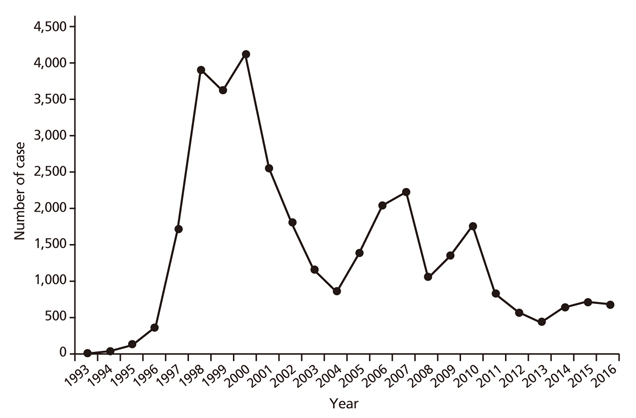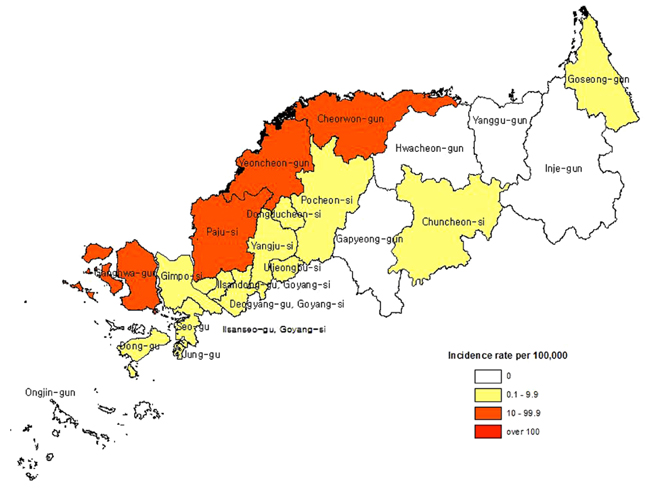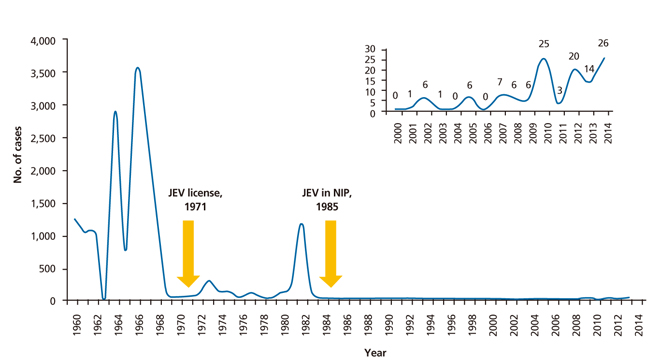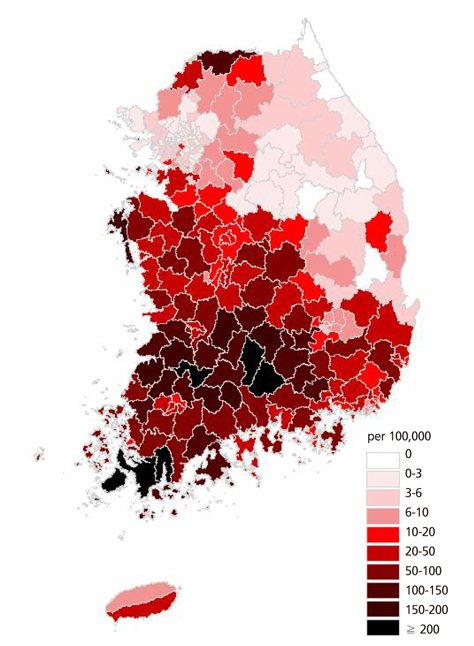J Korean Med Assoc.
2017 Jun;60(6):451-457. 10.5124/jkma.2017.60.6.451.
Domestic and international trend of vector-borne disease
- Affiliations
-
- 1Division of Infectious Disease Surveillance, Korea Centers for Disease Control and Prevention, Cheongju, Korea. ldhmd@korea.kr
- KMID: 2384390
- DOI: http://doi.org/10.5124/jkma.2017.60.6.451
Abstract
- The incidence of vector-borne diseases has increased with climate change and developments of transportation. Malaria was eliminated in the early 1980s in Korea, but one domestic case was reported in 1993. The number of patients increased to 4,142 in 2002, and less than 700 cases of malaria are reported annually nowadays. Additionally, approximately 70 to 80 imported malaria cases were reported annually, and most of them are Plasmodium falciparum infections from Africa. Annually, 20 to 40 cases of Japanese encephalitis are reported, and the incidence is high in individuals between the ages of 40 and 59. Moreover, 313 cases of dengue fever were imported in 2016, and most of them were from Southeast Asia. In 2016, 11,000 cases of scrub typhus were reported, and most of the patients were older than 50. The number of reported cases of severe fever with thrombocytopenia syndrome has been increasing since 2013, mostly in patients older than 60. It is important to avoid vectors for the prevention, and for the doctors to diagnose the apatients as soon as possible.
Keyword
MeSH Terms
Figure
Cited by 1 articles
-
Vector-borne infectious diseases
Young Hwa Choi
J Korean Med Assoc. 2017;60(6):449-450. doi: 10.5124/jkma.2017.60.6.449.
Reference
-
1. Young TS. Medical arthropod. Korea Society of Infectious Disease. Infectious disease. Seoul: Kunja;2014. p. 1005–1025.2. World Health Organization. World malaria report 2016. Geneva: World Health Organization;2016.3. Brady OJ, Gething PW, Bhatt S, Messina JP, Brownstein JS, Hoen AG, Moyes CL, Farlow AW, Scott TW, Hay SI. Refining the global spatial limits of dengue virus transmission by evidence-based consensus. PLoS Negl Trop Dis. 2012; 6:e1760.
Article4. Korea Centers for Disease Control and Prevention. Malaria management guideline. Cheongju: Korea Centers for Disease Control and Prevention;2017.5. Yeom JS, Ryu SH, Oh S, Choi DH, Song KJ, Oh YH, Lee JH, Kim YA, Ahn SY, Yang HY, Cha JE, Park JW. Evaluation of anti-malarial effects of mass chemoprophylaxis in the Republic of Korea army. J Korean Med Sci. 2005; 20:707–712.
Article6. Yeom JS, Jun G, Kim JY, Lee WJ, Shin EH, Chang KS, Bang JH, Oh S, Kang JY, Park JW. Status of Plasmodium vivax malaria in the Republic of Korea, 2008-2009: decrease followed by resurgence. Trans R Soc Trop Med Hyg. 2012; 106:429–436.
Article7. World Health Organization. Guidelines for the treatment of malaria. 3rd ed. Geneva: World Health Organization;2015.8. Korea Centers for Disease Control and Prevention. Epidemiology and management of vaccine preventable disease. 5th ed. Cheongju: Korea Centers for Disease Control and Prevention;2017.9. World Health Organization. Global strategy for dengue prevention and control, 2012-2020. Geneva: World Health Organization;2012.10. Thomas SJ, Endy TP, Rothman AL, Barrwtt AD. Flaviviruses. In : Bennett JE, Dolin R, Blaser MJ, editors. Mandell, Douglas and Bennett's principles and practice of infectious diseases. 8th ed. Philadelphia: Elsevier;2015. p. 1881–1903.11. Korea Centers for Disease Control and Prevention. Infectious diseases surveillance yearbook 2015. Cheongju: Korea Centers for Disease Control and Prevention;2016.12. Korea Centers for Disease Control and Prevention. Tick and mite borne disease management guideline. Cheongju: Korea Centers for Disease Control and Prevention;2017.13. Kim DM. Rickettsia. Korea Society of Infectious Disease. Infectious disease. Seoul: Kunja;2014. p. 709–726.14. Yu XJ, Liang MF, Zhang SY, Liu Y, Li JD, Sun YL, Zhang L, Zhang QF, Popov VL, Li C, Qu J, Li Q, Zhang YP, Hai R, Wu W, Wang Q, Zhan FX, Wang XJ, Kan B, Wang SW, Wan KL, Jing HQ, Lu JX, Yin WW, Zhou H, Guan XH, Liu JF, Bi ZQ, Liu GH, Ren J, Wang H, Zhao Z, Song JD, He JR, Wan T, Zhang JS, Fu XP, Sun LN, Dong XP, Feng ZJ, Yang WZ, Hong T, Zhang Y, Walker DH, Wang Y, Li DX. Fever with thrombocytopenia associated with a novel bunyavirus in China. N Engl J Med. 2011; 364:1523–1532.
Article15. Li Y, Zhou H, Mu D, Yin W, Yu H. Epidemiological analysis on severe fever with thrombocytopenia syndrome under the national surveillance data from 2011 to 2014, China. Zhonghua Liu Xing Bing Xue Za Zhi. 2015; 36:598–602.16. National Institute of Infectious Diseases. Severe fever with thrombocytopenia syndrome (SFTS) in Japan, as of February 2016. IASR. 2016; 37:39–40.
- Full Text Links
- Actions
-
Cited
- CITED
-
- Close
- Share
- Similar articles
-
- The Effect of Global Warming on Infectious Diseases
- Sero-survey on Aino, Akabane, Chuzan, bovine ephemeral fever and Japanese encephalitis virus of cattle and swine in Korea
- Modeling of transmission pathways on canine heartworm dynamics
- Current status and outlook of mosquito-borne diseases in Korea
- Present state and future of tick-borne infectious diseases in Korea






